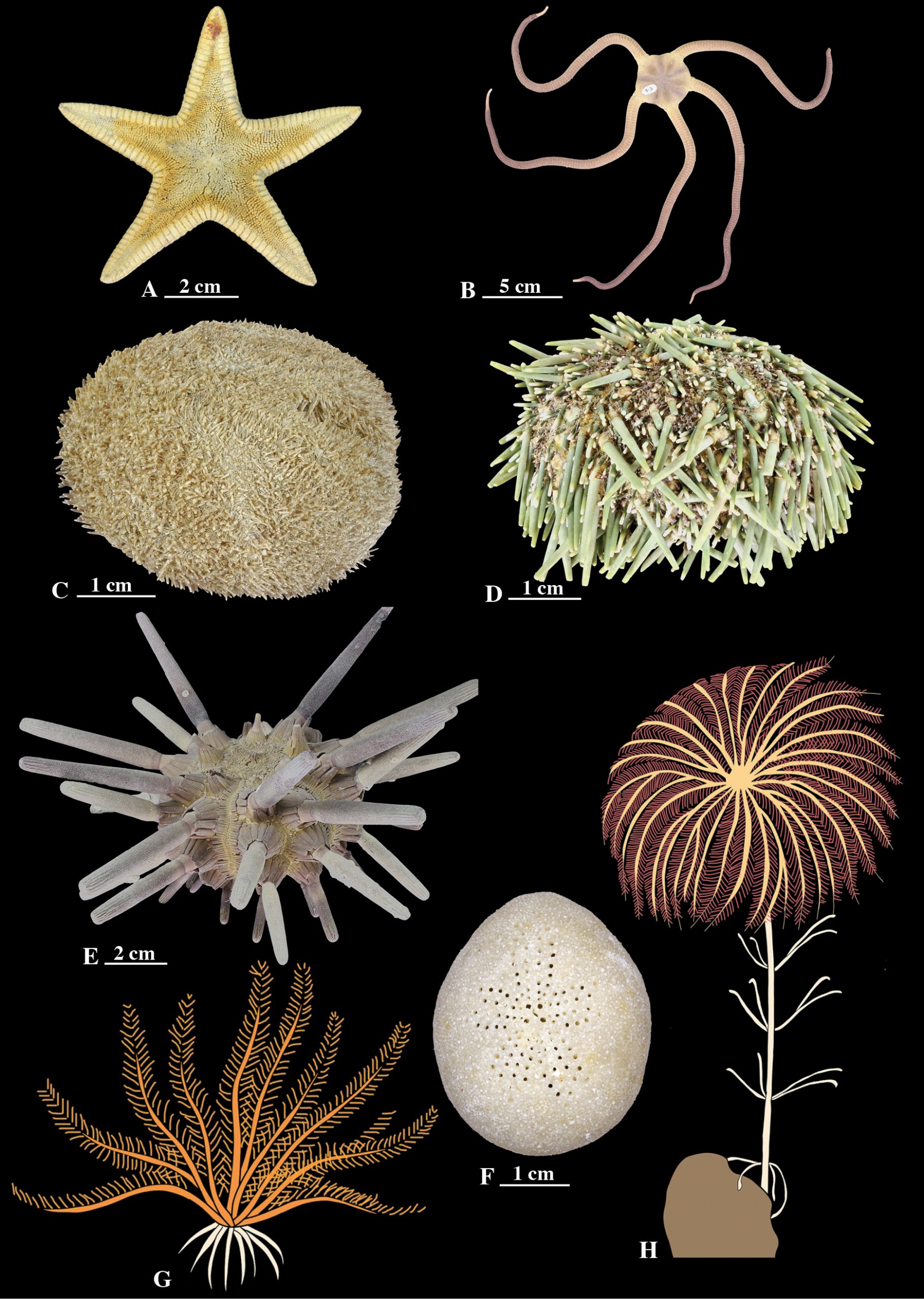Invertebrates: Echinoderms
Echinoderms are a highly diverse group of animals that are distinctive for their unique five-fold symmetry. Exclusively marine, echinoderms occupy a wide range of ecosystems ranging from intertidal rocky shores to deep ocean basins.

Different kinds of echinoderm. A. Starfish. B. Brittle star. C. Heart urchin with thousands of tiny spines. D. Sea urchin with many small spines. E. Pencil urchin with relatively few spines. F. Heart urchin with a star of pores for tube feet. G. An illustration of a mobile feather star crinoid with many arms and small “legs” or cirri. H. An illustration of a stalked crinoid attached to the substrate. Image credit: JH Robinson. |
The biodiversity within phylum Echinodermata is grouped into classes that will be familiar to almost everyone who has visited the seaside. Fossils from four of these classes are found in Aotearoa New Zealand. These are starfish or sea stars (class Asteroidea), sea lilies (class Crinoidea), brittlestars (class Ophiuroidea) and sea urchins (class Echinoidea). The remaining group, sea cucumbers (class Holothuroidea), has no fossil record in New Zealand – the only parts of the animal likely to be preserved are the tiny calcite spicules and none have been described to date.
Echinoderms have an endoskeleton or test made up of calcite ossicles or plates and a water vascular system in which ‘tube-feet’ are used for moving on or in the sea floor, and for breathing and feeding. Although the tube feet themselves are not preserved in fossils, the plates of the echinoderms that do we do find as fossils often show rows of pores. In life the tube-feet emerge through these pores. The pores often occur in bands known as ambulacra (ambulate means ‘move about’), alongside small knobs or bosses which form spine bases. Spines and plates come in many shapes and sizes and assist in identifying the species or genus to which the fossil belongs.
There are more than 600 species of echinoderms living in New Zealand seas today and ‘180 fossil species, 99 not named or identified as to species‘, so much more research remains to be done on this remarkable group of animals and their biodiversity history in Aotearoa.
Asteroids, ophiuroids and crinoids generally fall apart after death so they are relatively uncommon as fossils – and we have only a few fossils in the Geology Museum collections.
In contrast, the two subclasses of echinoids (cidaroids or regular echinoids) and irregular echinoids such as heart urchins have hard tests that fossilise well. Cidaroids have an almost circular outline while irregular echinoids can have a heart-shaped outline. Each of the small plates and spines in an echinoid are composed of single crystals of calcite. This is revealed when looking at a broken surface of a spine for example, which will show the diagnostic angled crystal face.
The University of Otago Geology Museum holds hundreds of specimens of fossil echinoderms, many collected from the limestones of North Otago and South Canterbury and calcareous sandstones around Dunedin. They range from large echinoids up to 20 cm in diameter, to tiny crinoid ossicles just 2 mm across.
Symmetry is a key feature in identifying animals, both living and fossil. Many, including humans, brachiopods and insects, exhibit bilateral symmetry, which is a body plan where an organism has a left side and a right side that are generally mirror images of one another. Cnidarians (corals and jellyfish) display radial symmetry, which is where the body is arranged regularly around a central point. Echinoderms are characterised by five-fold symmetry, also known as pentaradial symmetry. This is where, during a rotation around a central point, the body will appear to have a very similar outline at five different points during that rotation.
A level of the classification system used to organise life that is below kingdom and above class. Organisms in one phylum generally have a very different body plan to organisms in another phylum within the same kingdom.
A level of the classification system used to organise life that is below phylum and above order. Organisms in one class will have a body plan that shares key traits with organisms in another class within the same phylum. Generally though, organisms in the same phylum but different classes will have body plans that are clearly different to one another.
Evidence of life from a past geological age. Remains like bones, shells or wood, or an impression like a footprint, or some other evidence of life, from something that was alive more than 11,700 years ago.
A collection of fossils that document the history of life. Reference might be made to the history of life in a particular place ('the fossil record of New Zealand'), or the history of a particular group of organisms ('the fossil record of penguins'), or simply the global history of all life ('the fossil record').
A calcium carbonate mineral, CaCO3.
Structural support that is on the insider of an animal. The bones of a vertebrate are an example of an endoskeleton. The hard calcite parts of echinoderms are covered in a thin layer of soft tissue, which makes these another example of an endoskeleton.
A network of tubes through which fluid will circulate. Vertebrate animals like humans have a vascular systems that carries blood and which is important for respiratory gas circulation. . Echinoderms have a vascular system through which water flows, and which provides structural support and locomotion.
Mah CL, McKnight DG, Eagle MK, Pawson DL, Ameziane N, Vance DJ, Baker AN, Clark HES, Davey N. 2009. Phylum Echinodermata: sea stars, brittle stars, sea urchins, sea cucumbers, sea lilies. In: Gordon DP, editor. New Zealand inventory of biodiversity: 1. Kingdom Animalia: Radiata, Lophotrochozoa, Deuterostomia. Christchurch: Canterbury University Press. pp. 371–400.
The mineralised shell of some spherical organisms. For examples see foraminifera and echnioderms.

